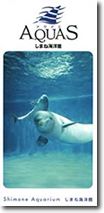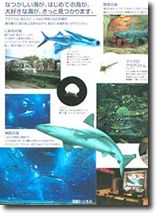|
Under
the Sea in Shinagawa
Whenever
Mother Nature is permitted to slip through a crack in Tokyo, there is
potential for something brilliant to happen. Though she tends to be caged,
pruned and exploited, and often seems like a fish out of water, she is
also celebrated and usually in top form. Shinagawa
Aquarium (Suizokukan), a recent addition to Tokyo's collection
of well-packaged nature, has offerings which include a wide variety of
ocean dwellers, most of whom are allowed to remain in the water. Imagine
embarking on an undersea excursion through the waters around Japan, down
throughSoutheast Asia, Oceania and into the Indian Ocean. Warm waters
stuffed to gills with beautiful creatures await you. But, as anyone who
has taken a trip from Tokyo knows, getting out of here is always a challenge,
We begin, then, with an underwater tour of Tokyo Bay. Plug your nose,
move quickly and pray there's no permanent damage.
The
Journey
This portion of the journey, which regrettably consumes too much of the
first floor, is comprised of River Flow Into Tokyo
Bay, a less-than-enthralling exhibit complete with plastic,
oddly tropical foliage and two charming ducks; and two other displays,
which intentionally or not, portray the local waterfront in a "then and
now" format. While it doesn't qualify for two much pondering, it is interesting
that the "then" exhibit depicts life on the Shinagawa shoreline long,
long ago. The crude models of dwellings and fishing boats clearly shows
a society adapting to life by the sea.
Ten steps further along, however, you are faced with a much different
scene. Shinagawa and the Sea would
be more appropriately titled The City That Ate Tokyo Bay. This dreary
tank contains a sparse population of timid little fish cowering in simulated
urban debris. The painted background of a relentless series of skyscrapers
in five shades of dull clearly states that the days of adapting are over.
Is this an attempt at environmental education, or are we expected to be
convinced that cinder blocks and plastic piping have added significantly
to the quality of life off the shores of Shinagawa? The recorded narration
might hold the answer, but as the text other than Japanese is not available
you may be left to draw your own conclusions.
Things
begin to look brighter as you pass the dismissible Tidal Basins display,
round the corner out of Tokyo Bay and head into The
Ocean. This is the main tank and you get to know it very well.
From above is the least spectacular of the three main views. Looking down
through the rippling surface you can make out the dark shapes of rays
and baby sharks, and more fish per cubic inch than even the Tsukiji fish
market can boast. Fresher, too. If you feel to compelled to dive in, don't
worry -- you're about to. But first before you head downstairs, take a
look behind you at the very attentive and well-behaved schooling fish.
No class clown here. No tacks on the teacher's chair or pigtails in the
ink well. Just hundreds of unblinking, vacant stares magnified to hideous
proportions by bubbled windows.
Heading down the tight staircase just beyond the Schooling Fish you emerge
on the ocean floor. Ahead of you is the narrow mouth of a 20-meter tunnel
that twists along the bottom of The Ocean, which you have just viewed
from above. The dimensions of the tunnel may conjure up visions of Shelley
Winters in The Poseidon Adventure, but it's worth the trauma, because
the narrowness and low height mean the fish are literally right in your
face. And you won't be able to swim through tight portholes in an evening
gown.
Inside
the tunnel the pace slows. The crowd falls silent and eyes widen. Warm
light dances all round you as hundreds of beautiful creatures in every
direction vie for your attention. Sharks cruise overhead, eels slither
wickedly over the glass, a ray glides by half an inch from your nose.
If it weren't for the glass, you could stick out your tongue and tickle
its belly. There are football-shaped groupers as big as blimps, a bunch
of little orange fish who look like Jimmy Durante, and a peculiar turtle-like
thing hovering off to left. To get to the bottom of this (pun intended),
turn left out of the tunnel.
The
Show
Just
ahead of you, you may see a young captain Nemo-type character seated at
a control panel, apparently orchestrating the goings-on inside the tank.
No, it is just the Walking Through The Sea With a Turtle Attraction. Turtle
Cam, actually. For a fee you can view The Ocean from inside, using joy-sticks
to make the "turtle" rotate, zoom and do all the things you have always
wanted to make a turtle do but lacked the proper technology. And you can
see what he sees by watching the monitor. With that, you get to know these
fish about as well as you can without getting you hair wet. This is a
good time to take in the Dolphin Show.
At this point, you are just halfway through the exhibits, and near the
stairs (remember not to rise faster than your bubbles) is the dolphin
arena. Performances (three shows in weekdays) and five on weekends) last
about 15 minute, but keep in mind that the seating area is very small,
and even when the aquarium is uncrowded there is not nearly enough seats
for everyone. If you do find yourself having a hard time getting a clear
view, try going downstairs where you can watch the show from underwater.
The Dolphin Show itself is a standard repertoire of dolphin tricks; hula-hoops,
boogie boards, moonwalking, etc. What makes it interesting is that these
dolphins are a little wet behind the ears. Not yet aware of the fact that
they are entertainers, they seem to enjoy jumping around and having smelt
thrown at them. (And who wouldn't?) The tricks are often repeated until
the dolphins perform then correctly or become completely distracted by
something else. They are really just showing off for the men with the
fish buckets and their happy-go-lucky oblivion is quite refreshing. In
fact, the schooling fish could benefit from a field trip over here.
Cold
Shoulders
Resubmerging to basement level, you come to realize that this floor is
infinitely more interesting than the first. The
Cold Current Fish tank, for example, displaying beasts from
the waters around Honshu and Hokkaido, is home to the limber giant crab
who is constantly giving himself a manicure, then scraping his pointy
toes across the glass. In Animals of the Cold
Sea you may be disappointed that the animals in question turn
out to be one animal in triplicate, but these harbor seals are so good
natured that it is hard to hold a grudge. Next door is a Humpheaded Wrasse
who you just call "sir." This guy is so big his lips alone are sashimi
for 60, and it is only his beautiful coloring that saves him from being
a shoe-in for "ugliest resident" status.
A series of small tanks lining the adjacent corridor offers you a glimpse
at what can only be called novelty fauna. Along one side, you see leaf
fish swimming with leaves, glass fish swimming around fine leaded crystal
(this gimmick is a bit transparent, don't you think?), and seahorses clinging
to a musical scale, wondering how they have come to be part of this living
cliche. The facing wall houses a darker collection of a more predatory
nature. A giant octopus, a family of moray eels, and piranhas, to name
but a few. It is interesting to check out who is drawn to which side of
this passage.
Fishes From the Large River in the World,
apart from containing the aquarium's only glaring signage error,
has little to offer. It is a big, big tank with some big, big fish, but
no big deal. The next tank, Jewels of the Sea seems to be a chunk of the
Great Barrier Reef. Hands-down the most beautiful in the aquarium, this
tank offers the kind of aquatic flora and fauna that come to mind when
you hear the words "aquatic flora and fauna." It is a vibrant, living
mural, and is well positioned as the last tank and final ovation.
There is much about the Shinagawa Aquarium that is mediocre and a couple
of things that may even make you angry, but if you can spend a few minutes
watching dolphins jump in the light of the moon, you'll be happy you came.
A visit to the Shinagawa Aquarium is a very pleasant way to spend an afternoon
-- if you remember not to look too deeply.
|


